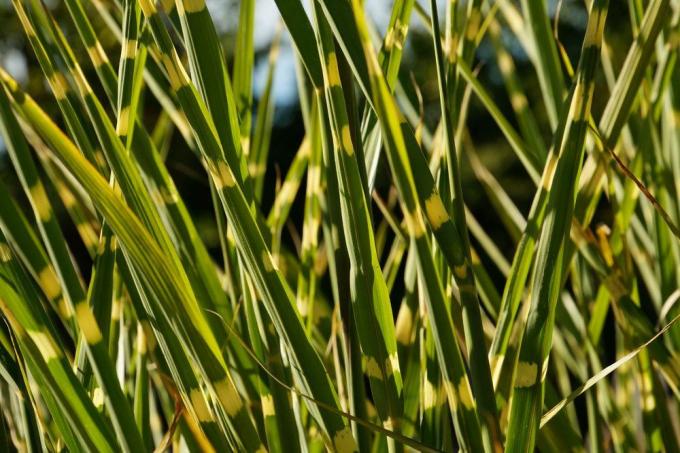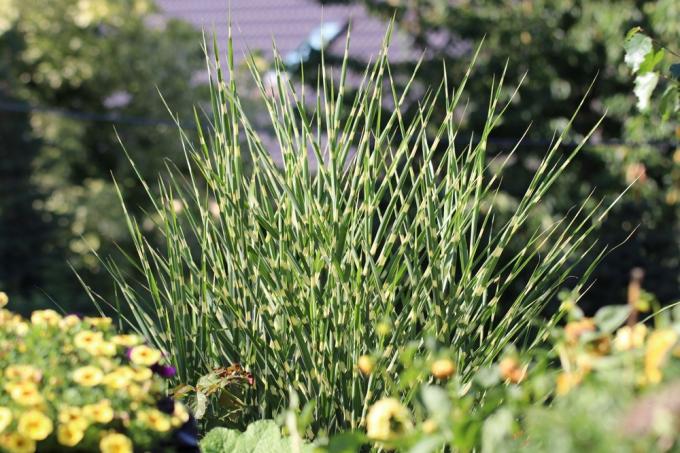
table of contents
- Caution: risk of confusion
- Zebra grass overwinter in the garden
- Steps 1-3
- Steps 4-7
- Tiger grass overwinter in the bucket
- Steps 1-3
- Steps 4-7
Miscanthus sinensis, the Chinese reed, is one of the most popular ornamental grasses in German gardens. Also known as zebra grass, Tiger grass or elephant grass, the sweet grass is often kept outdoors or in pots and inspires all year round with the striped stalks in different colors. Since the grasses are extremely robust plants, winter protection can be implemented without any problems.
Caution: risk of confusion
Before you can prepare the grass for winter, you need to check that your specimen is really Miscanthus sinensis. Another plant known as tiger grass is available on the market: the Indian pennywort Centella asiatica. This plant is not a sweet grass, but a marsh plant that occurs worldwide in the tropics and subtropics. The Indian pennywort differs significantly from the Chinese reed:
- not hardy
- round or kidney-shaped leaves
- does not form stalks
Except for the nickname, the two plants have nothing in common and it would be a fatal mistake to keep the pennywort outside over the winter. Therefore, you should definitely check whether the plant is Chinese reed or pennywort when you buy a plant called tiger grass. Since both plants like to be planted near water, they can usually be found in the same category, which increases the likelihood of confusion.

right: Centella asiatica, Indian pennywort
Zebra grass overwinter in the garden
Instructions in 7 steps
Chinese reed as a garden plant is much easier to overwinter than in a bucket. Since the stalks of Miscanthus sinensis are completely hardy, only the root ball needs to be protected, which is also quite robust. The following instructions explain the individual points that are necessary for this part of the maintenance:
Steps 1-3
1. Only cut after winter
If you keep zebra grasses outdoors, you should definitely make use of the plant's protective mechanisms. Zebra grass should never be cut back in the garden, as the stalks actually act as winter protection for the plant and are therefore ideal for wintering. The plants are only cut after winter in early spring, which significantly improves the sprouting of the new stalks. The best: the stalks dry up, but do not lose their color. As a result, they work effectively against the dreary gray of winter.
2. Location
You do not need a special location in the garden for the zebra grass over the winter. As long as the location meets the requirements of the Chinese reed, you can leave the plant there. If it is too dark, you should definitely choose a sunnier place, as the sweet grass likes it sunny even over the winter. Without enough sun, the plant weakens over the cold season and is no longer so well protected. However, winter protection is always required after transplanting, as the roots still have to establish themselves in the new place.
3. Freshly planted grasses
As such, the grasses do not have to be provided with winter protection, unless they are freshly planted specimens. Planting in mid-May is recommended. Mid to late summer is also possible, but roots that are not long enough have not developed over this short period of time. This can affect the elephant grass in cold temperatures.
Steps 4-7
4. Tie the straws together
Before you distribute the winter protection, you must tie the stalks together so that they can protect the root ball even better. This step is not necessary in regions with mild winters. If you want to be on the safe side, you should tie them together anyway:
- put on gardening gloves
- Zebra grass stalks are very sharp
- use sisal cords to tie them together
- alternatively, ropes made from coconut fibers can be used
- from the bottom, wrap the zebra grass
- do not wrap too tightly
- just so that the stalks stick together
- repeat this step up to the top
- Finally, guide the cord back to the floor
- knot
- Place the bamboo stick in the middle of the zebra grass
- the bamboo stick acts as protection against snow loads and wind
5. Winter protection
The winter protection has the task of protecting the root ball from the cold and also stores moisture, which is important for the survival of Miscanthus sinensis. The winter protection is set up as follows after the grass has been tied:
- Spread a layer of sticks, straw or leaves around the root ball
- Wrap tied stalks in half
- garden fleeces are ideal for this
- The ends of the straw should protrude from the fleece
6. Fertilize
No fertilizer is given for the entire winter. The plant simply does not need this over the cold season, as it takes a rest phase.
7. to water
On frost-free days, be sure to check the soil for possible dryness. If this is the case, add a little more to prevent the grass from drying out. That is one of the greatest dangers for the plant.

tip: When tying the stalks together, you don't just have to fasten them at the top. The stalks can be braided very well and thus integrated decoratively into the winter garden.
Tiger grass overwinter in the bucket
Instructions in 7 steps
Hibernating Miscanthus sinensis looks different in the pot. Since the sweet grass is not planted directly in the ground, it definitely needs complete winter protection. The risk of the pot freezing is far too great. Follow these instructions to optimize maintenance over the winter:
Steps 1-3
1. Location
The most important thing when wintering a tiger grass in a pot is the location. The grass needs a place that has the following properties:
- Light requirement: sunny
- dry
- should be ventilated
You have either unheated, bright rooms such as winter gardens with a window or a Have door for ventilation, or dry outdoor locations that are protected from excessive moisture from above are. Canopies are recommended here, for example. In any case, the plants should get enough sun. Different preparation will be required depending on where you place your copy.
2. Cut
Before you can overwinter the zebra grass in the pot in the house, you must first cut it to size. The Chinese reed can quickly get too high in the pot and should therefore be trimmed a little. Simply use sharp, disinfected scissors and gloves for this. Then cut back to the desired height. Make sure you leave at least ten centimeters of the stalks so that bacteria or mold cannot settle on the plant.
3. Hibernate the bucket outdoors
If you want to overwinter the container plant outdoors, you do not need to cut it. To do this, tie the stalks together according to the instructions described above.
Steps 4-7
4. Winter protection
When the potted plants overwinter outdoors, there is now no winter protection. This ensures that the vessel does not freeze through. For this, choose either bubble wrap or a garden fleece and wrap the container and the lower part of the plant generously with it. Also cover the substrate slightly from above so that moisture cannot accidentally penetrate on frosty days. In the worst case, this can lead to mold.
5. Fertilize
Container plants are also not fertilized over the winter, even if they overwinter in the house. The dormant phase of the plant is very extensive and therefore no fertilizer is required.
6. to water
Watering must never be forgotten over the winter. Since the plant only has a certain amount of substrate, it cannot really store water and is therefore dependent on the addition of water. You should also only water here in frost-free times when the pot is outdoors or regularly when the container can look forward to a place indoors. Make sure, however, that the substrate does not form waterlogging so that it cannot rot.
7. Base for the bucket
Finally, it is advisable to place the pots on a surface. Since the bottom of the jars must not be packed, it tends to freeze through from below. The following materials are ideal as a base for the zebra grass:
- Styrofoam
- Block of wood

